RECENT UPDATES
 |
| |
 |
| |
 |
| |
 |
| |
 |
| |
 |

LED Projectors versus UHP Projectors
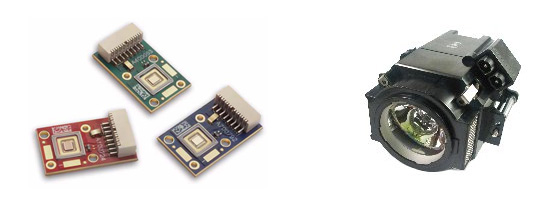 There's been considerable discussion regarding the advantages and disadvantages of the LED projector versus the UHP (or conventional) digital projector. This article will briefly examine the UHP and LED light source for projectors and discuss the advantages and disadvantages of each technology.
There's been considerable discussion regarding the advantages and disadvantages of the LED projector versus the UHP (or conventional) digital projector. This article will briefly examine the UHP and LED light source for projectors and discuss the advantages and disadvantages of each technology.
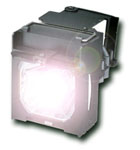 The "Standard" Projector Lamp (UHP) – The "standard" digital projector lamp employed by most projectors these days is the UHP lamp, which stands for Ultra High Performance. However those in the industry like to refer to this lamp as the "Ultra High Pressure" light source because of its tendency to explode! Without getting too technical this lamp operates at extremely high pressures and temperatures, often in excess of 950C – the same temperature as your vehicle's engine exhaust! The advantages of the UHP lamp is simple – Brightness. The UHP lamp delivers massive amounts of brightness, a single 150W lamp can deliver over 9000 Lumens, about 10x brighter than your average automotive headlight.
The "Standard" Projector Lamp (UHP) – The "standard" digital projector lamp employed by most projectors these days is the UHP lamp, which stands for Ultra High Performance. However those in the industry like to refer to this lamp as the "Ultra High Pressure" light source because of its tendency to explode! Without getting too technical this lamp operates at extremely high pressures and temperatures, often in excess of 950C – the same temperature as your vehicle's engine exhaust! The advantages of the UHP lamp is simple – Brightness. The UHP lamp delivers massive amounts of brightness, a single 150W lamp can deliver over 9000 Lumens, about 10x brighter than your average automotive headlight.
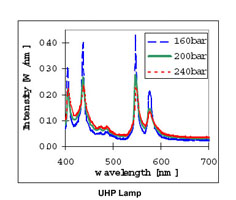 This massively bright light-source allows projectors to achieve, 2000, 3000, and sometimes even 4000 lumens or more – bright enough to punch through even sunlight for a clear, bright, projected display. However the disadvantages of UHP lamps are many. First many of these lamps only last a thousand hours. Most manufacturers claim 2000-3000 hours, but those are usually laboratory operating hours, real world conditions sometimes yield less than 1000 hours of operating time. UHP lamps are expensive to replace, often $200-300 for the lamp assembly, with most of the cost built into safety and cooling features needed to operate the UHP lamp. Secondly these lamps, often have problems delivering a stable color spectrum as they age. Unlike LEDs which have very distinguished and stable color outputs, the color output of a UHP lamp tends to change over-time, which can lead to a washed out or otherwise unbalanced display.
This massively bright light-source allows projectors to achieve, 2000, 3000, and sometimes even 4000 lumens or more – bright enough to punch through even sunlight for a clear, bright, projected display. However the disadvantages of UHP lamps are many. First many of these lamps only last a thousand hours. Most manufacturers claim 2000-3000 hours, but those are usually laboratory operating hours, real world conditions sometimes yield less than 1000 hours of operating time. UHP lamps are expensive to replace, often $200-300 for the lamp assembly, with most of the cost built into safety and cooling features needed to operate the UHP lamp. Secondly these lamps, often have problems delivering a stable color spectrum as they age. Unlike LEDs which have very distinguished and stable color outputs, the color output of a UHP lamp tends to change over-time, which can lead to a washed out or otherwise unbalanced display.
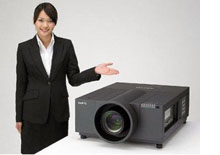 Additionally UHP lamps, like most filament based light-bulbs, are less durable than LEDs. When travelling with a projector it is not uncommon to have the UHP lamp fail due to the bumps and shock of travel. And finally UHP lamps are big. Primarily due to extensive cooling systems required, it is extremely difficult to build a small UHP lamp projector. The inability to miniaturize the UHP lamp projector results in low portability compared to the new LED based pico, micro, and mini projectors. Despite the disadvantages of the UHP lamp, ultra-high brightness projectors will always be in demand. With LED projectors unable to come close to matching the brightness level of the UHP projector, the UHP lamp projector will remain a projector light source for years to come.
Additionally UHP lamps, like most filament based light-bulbs, are less durable than LEDs. When travelling with a projector it is not uncommon to have the UHP lamp fail due to the bumps and shock of travel. And finally UHP lamps are big. Primarily due to extensive cooling systems required, it is extremely difficult to build a small UHP lamp projector. The inability to miniaturize the UHP lamp projector results in low portability compared to the new LED based pico, micro, and mini projectors. Despite the disadvantages of the UHP lamp, ultra-high brightness projectors will always be in demand. With LED projectors unable to come close to matching the brightness level of the UHP projector, the UHP lamp projector will remain a projector light source for years to come.
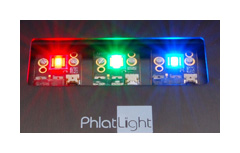 The LED projector - New to the projector industry and to lighting in general is the LED. The light-emitting-diode is a semiconductor that emits light when energy is applied. Because it is a semiconductor it is capable of being extremely small yet emitting high brightness. The advantages of LED projectors are many. To begin the LEDs in a LED projectors last 10 to 100 times longer than traditional UHP lamps. Many LED projectors can operate for 10,000 to 100,000 hours or more due to the long lasting LED light source. A LED projector does not need to worry about bulb changes – if a 15,000 hour LED projector was a full time employee it could operate for 7.5 years without burning out! This means that there are no "consumables" or maintenance costs associated with an LED projector compared to a regular UHP projector.
The LED projector - New to the projector industry and to lighting in general is the LED. The light-emitting-diode is a semiconductor that emits light when energy is applied. Because it is a semiconductor it is capable of being extremely small yet emitting high brightness. The advantages of LED projectors are many. To begin the LEDs in a LED projectors last 10 to 100 times longer than traditional UHP lamps. Many LED projectors can operate for 10,000 to 100,000 hours or more due to the long lasting LED light source. A LED projector does not need to worry about bulb changes – if a 15,000 hour LED projector was a full time employee it could operate for 7.5 years without burning out! This means that there are no "consumables" or maintenance costs associated with an LED projector compared to a regular UHP projector.
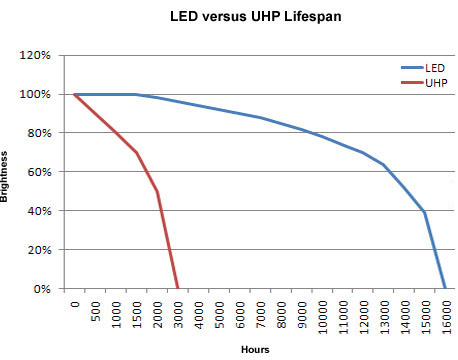
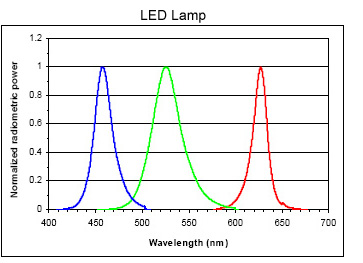 LED projectors have substantial advantages in terms of color quality and stability. Projectors that employ a red-green-blue (RGB) light source are capable of producing vibrant and color-rich displays compared to the UHP projector. (Note: don't confuse RGB LED projectors with white LED projectors. White LED projectors while capable of producing good quality images do not have the rich color quality of RGB LED projectors). Additionally LEDs by nature are extremely stable throughout their operating life-span and so you will not need to frequently "re-tune" an LED projector like a UHP projector.
LED projectors have substantial advantages in terms of color quality and stability. Projectors that employ a red-green-blue (RGB) light source are capable of producing vibrant and color-rich displays compared to the UHP projector. (Note: don't confuse RGB LED projectors with white LED projectors. White LED projectors while capable of producing good quality images do not have the rich color quality of RGB LED projectors). Additionally LEDs by nature are extremely stable throughout their operating life-span and so you will not need to frequently "re-tune" an LED projector like a UHP projector.
Finally because LEDs are small and operate at much lower temperatures (less than 90C compared to 900C) LED projectors can be designed to be extremely small, light and most importantly portable. In fact an LED projector can be so small as to the size of a cell phone. These projectors are known as pico or micro projectors. That said there are currently a distinct disadvantage of LED projectors – brightness. LEDs while rapidly increasing in brightness still are not able to emit the raw brightness that a UHP lamp is capable of. Most LED projectors currently produce only around 50-500 lumens, when taken into context is comparable to the digital projectors of 5-10 years ago, but does require turning off the lights to see a clear, vibrant picture. Of course, 50-500 lumens is still a far-cry from the 2000-5000 lumens of some UHP projectors available for sale. So while the advantages of LED projectors are plentiful users, that require raw sunlight piercing brightness, will need to continue using the UHP projector for at least a few more years.
ONLINE SPECIALS

AAXA P4 Pico Projector
WVGA • 80 lumens
Windows CE • 11 oz.
$339.00
More Info

AAXA P3 Pico Projector
1024x600 • 50 lumens
HDMI & Media Player
$269.00
More Info

AAXA P1 Jr. Pico Projector
Media Player • 1 Hour Battery
SD Card and USB Reader
$109.00
More Info

AAXA M2 Micro Projector
1024x768 • 110 lumens
HDMI & Media Player
$339.00
Order Now

AAXA M1 Micro Projector
800x600 • 75 lumens
Supports AVI, RMVB, MP3
$249.00
More Info
AAXA OUTLET STORE
